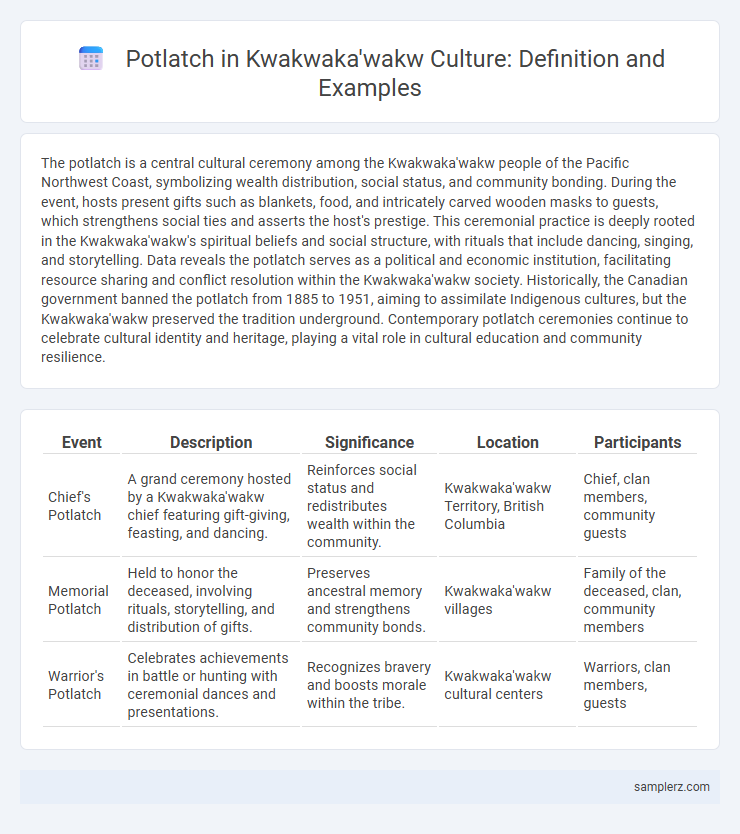The potlatch is a central cultural ceremony among the Kwakwaka'wakw people of the Pacific Northwest Coast, symbolizing wealth distribution, social status, and community bonding. During the event, hosts present gifts such as blankets, food, and intricately carved wooden masks to guests, which strengthens social ties and asserts the host's prestige. This ceremonial practice is deeply rooted in the Kwakwaka'wakw's spiritual beliefs and social structure, with rituals that include dancing, singing, and storytelling. Data reveals the potlatch serves as a political and economic institution, facilitating resource sharing and conflict resolution within the Kwakwaka'wakw society. Historically, the Canadian government banned the potlatch from 1885 to 1951, aiming to assimilate Indigenous cultures, but the Kwakwaka'wakw preserved the tradition underground. Contemporary potlatch ceremonies continue to celebrate cultural identity and heritage, playing a vital role in cultural education and community resilience.
Table of Comparison
| Event | Description | Significance | Location | Participants |
|---|---|---|---|---|
| Chief's Potlatch | A grand ceremony hosted by a Kwakwaka'wakw chief featuring gift-giving, feasting, and dancing. | Reinforces social status and redistributes wealth within the community. | Kwakwaka'wakw Territory, British Columbia | Chief, clan members, community guests |
| Memorial Potlatch | Held to honor the deceased, involving rituals, storytelling, and distribution of gifts. | Preserves ancestral memory and strengthens community bonds. | Kwakwaka'wakw villages | Family of the deceased, clan, community members |
| Warrior's Potlatch | Celebrates achievements in battle or hunting with ceremonial dances and presentations. | Recognizes bravery and boosts morale within the tribe. | Kwakwaka'wakw cultural centers | Warriors, clan members, guests |
Origins of Potlatch in Kwakwaka’wakw Culture
The potlatch ceremony in Kwakwaka'wakw culture originated as a complex social event deeply rooted in their indigenous traditions of the Pacific Northwest. It serves as a vital ritual for redistributing wealth, affirming status, and strengthening kinship ties within the community. Historically, potlatches symbolize the spiritual and social values passed down through generations, reflecting the Kwakwaka'wakw's connection to their ancestral heritage.
Social Significance of the Kwakwaka’wakw Potlatch
The Kwakwaka'wakw potlatch serves as a crucial social institution, reinforcing community bonds and status hierarchies through ritualized gift-giving and feasting. This ceremony validates leadership roles and redistributes wealth, ensuring social cohesion and reciprocity within the tribe. It also functions as a means of cultural preservation, passing down oral histories and traditional knowledge across generations.
Traditional Ceremonies and Rituals of Potlatch
The Kwakwaka'wakw potlatch is a complex traditional ceremony central to their cultural identity, involving the distribution of wealth, feasting, dancing, and storytelling. This ritual marks important life events such as births, marriages, and leadership transitions, reinforcing social status and community bonds. Symbolic masks, regalia, and songs are integral to the potlatch, serving as both spiritual expressions and historical records.
Gift-Giving and Reciprocity in Kwakwaka’wakw Potlatch
The Kwakwaka'wakw potlatch centers on elaborate gift-giving ceremonies that reinforce social status and community bonds through reciprocal exchanges. Chiefs distribute valuable items such as blankets, copper, and food to guests, who are expected to reciprocate in future potlatches, ensuring a continuous cycle of generosity and obligation. This system of reciprocity serves as a foundation for maintaining wealth distribution, social hierarchy, and cultural cohesion within Kwakwaka'wakw society.
Symbolism and Meaning Behind Potlatch Practices
The Kwakwaka'wakw potlatch symbolizes social status, wealth redistribution, and spiritual power through intricate ceremonies involving feasting, dancing, and gift-giving. Masks, regalia, and storytelling during the potlatch express ancestral connections and reinforce community identity. These practices underscore the potlatch's role in maintaining social order and cultural continuity among the Kwakwaka'wakw people.
Role of Chiefs and Elders in Potlatch Events
In Kwakwaka'wakw potlatch events, chiefs and elders hold pivotal roles as ceremonial leaders and custodians of cultural knowledge. Chiefs assert their status by distributing wealth and gifts, reinforcing social hierarchies and community bonds. Elders guide ritual practices, preserve oral histories, and ensure the accurate transmission of traditions during these significant gatherings.
Historical Suppression of the Kwakwaka’wakw Potlatch
The Kwakwaka'wakw potlatch, a central cultural ceremony involving feasting, gift-giving, and spiritual rituals, faced severe suppression during Canadian government bans from 1885 to 1951, aiming to eradicate Indigenous practices. Despite these prohibitions, the Kwakwaka'wakw covertly preserved the potlatch tradition, ensuring its survival through clandestine gatherings and oral transmission. This historical suppression profoundly impacted the community's cultural expression but ultimately reinforced the resilience and revival of Kwakwaka'wakw identity in contemporary times.
Potlatch as a Marker of Status and Wealth
In the Kwakwaka'wakw culture, the potlatch serves as a prominent marker of status and wealth, where hosts demonstrate their social rank through lavish gift-giving and elaborate ceremonies. The distribution of valuable items such as blankets, copper shields, and carved wooden objects publicly affirms the host's position within the community hierarchy. This complex ritual not only reinforces social bonds but also establishes long-term prestige and influence for individuals and their families.
Revival and Contemporary Practices of Potlatch
The Kwakwaka'wakw potlatch has experienced a significant revival since the lifting of the Canadian potlatch ban in 1951, with contemporary ceremonies blending traditional rituals and modern artistic expressions. Elders and cultural leaders play a crucial role in mentoring younger generations, ensuring the transmission of songs, dances, and storytelling integral to the potlatch. Today, potlatches serve not only as vital cultural gatherings but also as platforms for political advocacy and the reinforcement of Indigenous identity among the Kwakwaka'wakw people.
Potlatch’s Influence on Kwakwaka’wakw Identity and Heritage
The potlatch among the Kwakwaka'wakw is a central cultural ceremony that reinforces social structure, lineage, and community bonds by redistributing wealth through elaborate gift-giving. This tradition serves as a living archive of Kwakwaka'wakw history, mythology, and ancestral rights, embedding identity within the ritual's symbols and performances. The endurance of the potlatch strengthens cultural continuity and sovereignty, making it a vital expression of Kwakwaka'wakw heritage and resilience.

example of potlatch in Kwakwaka’wakw Infographic
 samplerz.com
samplerz.com